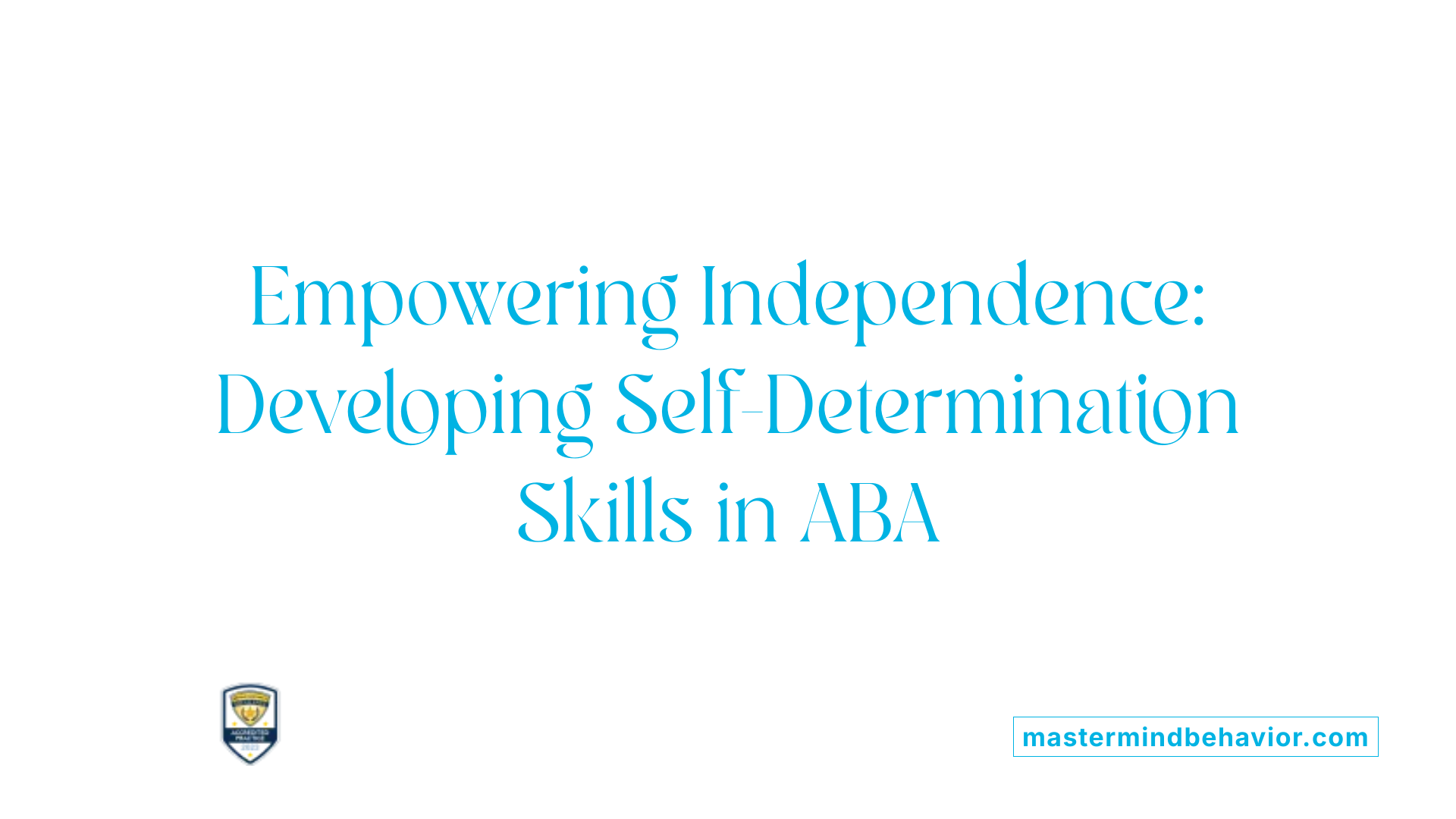The Role Of ABA Therapy In Developing Self Determination Skills

Understanding ABA Therapy and Its Impact on Self-Determination
Applied Behavior Analysis (ABA) therapy is a scientifically grounded approach designed to support individuals with autism spectrum disorder (ASD) by modifying behavior and fostering essential life skills. Beyond addressing challenging behaviors, ABA emphasizes empowering individuals through self-determination—enabling choice, decision-making, and independence. This article explores how ABA therapy plays a pivotal role in developing self-determination skills, enhancing quality of life for those with autism.
Foundations of Applied Behavior Analysis (ABA) Therapy
What is Applied Behavior Analysis (ABA) therapy, and how is it used to support individuals with autism?
Applied Behavior Analysis (ABA) therapy is a natural science that applies behavioral principles to address socially important challenges, especially for individuals with autism spectrum disorder (ASD). It focuses on increasing positive behaviors such as communication, social interaction, and daily living skills, while reducing behaviors that may be harmful or interfere with learning.
Definition and scientific basis of ABA
ABA is grounded in the analysis of behavior: understanding how environmental factors influence actions. Behavioral principles like reinforcement, prompting, and shaping are used to modify behaviors. This scientific approach involves studying the antecedents (what happens before a behavior), behaviors themselves, and consequences that maintain or reduce behaviors.
Behavioral principles used in ABA
Key behavioral strategies include identifying reinforcers that encourage desired behaviors and focusing on pivotal skills that influence multiple areas of development. Techniques such as Discrete Trial Training, Pivotal Response Training, and Natural Environment Teaching are tailored to the individual to promote skill acquisition in meaningful ways.
Tailoring interventions to individual needs
ABA programs start with thorough assessments to design personalized interventions. They set clear goals based on the individual's strengths and challenges, monitor progress systematically, and adjust plans accordingly. Caregiver involvement is critical to generalize skills across settings.
This individualized approach ensures that interventions are socially significant, promoting independence, communication, and participation in daily activities. Early and intensive ABA therapy has shown remarkable gains in communication, academic achievement, and community involvement for many children with autism.
| Aspect | Description | Benefit |
|---|---|---|
| Scientific Basis | Analysis of behavior patterns and environmental influences | Allows precise, data-driven interventions |
| Behavioral Principles | Reinforcement, prompting, shaping, and focusing on pivotal skills | Enhances learning and behavior change |
| Individualized Programs | Assessments, goal-setting, caregiver training, and progress tracking | Tailors treatment to unique needs |
ABA therapy remains one of the most effective, evidence-based approaches to supporting individuals with autism, emphasizing respect, skill-building, and meaningful participation in life.
Who Provides ABA Therapy? The Professionals Behind the Process

Roles of BCBAs and RBTs
ABA therapy services for individuals with autism are typically provided by highly trained professionals such as Board-Certified Behavior Analysts (BCBAs) and Registered Behavior Technicians (RBTs). BCBAs are responsible for conducting thorough assessments, designing individualized intervention plans, and overseeing the therapy process. Meanwhile, RBTs implement the day-to-day interventions under BCBA supervision, delivering skill-building exercises and behavior support based on evidence-based strategies.
Settings Where ABA is Delivered
ABA therapy can be delivered in diverse settings to best suit each individual's needs. Common locations include in-home environments, enabling personalized and naturalistic intervention; center-based clinics where specialized equipment and resources are available; school settings that allow for integration with educational goals; and through telehealth services providing access to families in remote locations. This flexibility helps tailor treatment to the individual's lifestyle and community.
Collaboration Among Therapists, Caregivers, and Community
Effective ABA therapy relies on collaboration among therapists, caregivers, and community members. Caregivers play an essential role in reinforcing skills and strategies outside of therapy sessions, while licensed clinicians and community resources contribute critical support services. This team-based approach fosters continuity, generalization of skills, and ensures interventions are meaningful and aligned with the person's values and preferences.
Together, these professionals and collaborators work to promote social interaction, communication, daily living, and independence for individuals with autism, applying scientific principles in a compassionate, person-centered framework.
Historical Context and Evolution of ABA Therapy
Origins with Dr. Ivar Lovaas
ABA therapy began with pioneering research by Dr. Ivar Lovaas, who demonstrated that behavioral principles could modify behaviors in children with autism. His early work was groundbreaking, showing that some children undergoing intensive ABA interventions could experience significant developmental gains, with a few even losing their autism diagnosis.
Early Intensive Behavioral Interventions (EIBI)
Building on Lovaas' foundation, Early Intensive Behavioral Intervention became a hallmark of ABA therapy for young children with autism. EIBI is characterized by high-intensity, individualized programs that emphasize communication, social skills, and adaptive behaviors. These interventions have led to remarkable improvements in academic achievement and community participation for many children.
Developments Leading to Modern ABA Frameworks
Over time, ABA has expanded beyond early childhood interventions to incorporate broader goals centered on quality of life (QOL) for individuals across the lifespan. Modern frameworks, such as Schalock’s QOL domains, guide practitioners to address areas like self-determination, emotional well-being, and inclusion. These developments ensure that ABA interventions are not only effective but also socially meaningful and respectful of individual values and preferences.
Core Components and Techniques of ABA Therapy
What is Reinforcer Identification?
Reinforcer identification is a fundamental step in ABA therapy where the therapist determines what motivates the individual. These motivators, known as reinforcers, are used to encourage positive behavior and skill acquisition. Tailoring reinforcers to the individual's preferences helps increase engagement and effectiveness of interventions.
How does Discrete Trial Training work?
Discrete Trial Training (DTT) breaks down skills into small, manageable steps taught one at a time. Each trial consists of a clear instruction, a prompt if needed, the individual’s response, and a consequence such as a reinforcer. This structured approach allows for consistent practice and immediate feedback, facilitating faster learning of targeted behaviors.
What is Pivotal Response Training?
Pivotal Response Training (PRT) targets pivotal areas of a person's development such as motivation, self-management, and initiation of social interactions. By focusing on these pivotal behaviors, PRT aims to produce widespread improvements across other skills. It is a naturalistic method that integrates learning opportunities into the individual's daily activities and encourages active participation.
How is Natural Environment Training utilized?
Natural Environment Training (NET) embeds teaching moments within everyday environments and routines. Instead of structured sessions, NET uses natural contexts to promote skill learning, making generalization of skills more likely. This approach helps individuals apply new abilities in real-life situations, enhancing their independence and social inclusion.
These core components of ABA therapy—reinforcer identification, DTT, PRT, and NET—work together to create effective, individualized behavioral interventions. Each method complements the others, allowing practitioners to adapt techniques to meet unique needs while promoting meaningful and socially significant skill development.
Pre-Intervention Steps: Assessments and Planning
What are the initial evaluations in ABA pre-intervention?
Initial evaluations involve a comprehensive assessment of the individual's current skills, behaviors, and needs. This step is crucial to understand the unique profile of strengths and challenges, which helps in forming a baseline for intervention. These assessments typically include direct observation, standardized tests, and interviews with caregivers to gather a complete picture of the individual's abilities and environmental factors.
How is an individualized intervention designed?
Following the evaluation, a tailored intervention plan is created based on the assessment data. The design focuses on targeting socially significant behaviors and skills aligned with the individual's and family's goals. A behavior analyst selects appropriate techniques such as Discrete Trial Training or Natural Environment Training, considering the person's preferences and developmental level to maximize engagement and effectiveness.
What is the role of caregiver training?
Caregiver involvement is a foundational element in ABA interventions. Training equips parents and caregivers with the skills to implement strategies consistently across settings, thereby promoting generalization and maintenance of learned behaviors. Caregiver training includes education on behavior principles, techniques for reinforcement, data collection, and how to respond to various behaviors effectively.
How are treatment hours established?
Treatment hours are determined based on the individual's needs, severity of challenges, and goals outlined in the intervention plan. This may range from intensive early intervention services to less frequent support, ensuring sufficient dosage for meaningful progress. Collaborative planning with caregivers, professionals, and funding sources helps structure an appropriate schedule that balances therapeutic needs and family priorities.
Addressing Challenging Behaviors with ABA: Functional Behavior Assessment (FBA)
What is the Purpose of FBA in ABA?
Functional Behavior Assessment (FBA) is a core service within Applied Behavior Analysis (ABA) that aims to identify the underlying causes and reasons behind challenging behaviors. By understanding these triggers and functions, behavior analysts can design more effective, targeted interventions that promote lasting behavioral change and improve an individual's quality of life.
How Are Behavior Triggers and Functions Identified?
FBA involves systematic observation and data collection to pinpoint what prompts and maintains specific behaviors. These may include environmental factors, social interactions, or emotional states. Once triggers and functions are clearly defined, behavior analysts can create strategies to modify or replace problematic behaviors with constructive alternatives.
Why Is Caregiver Involvement Important?
Involving caregivers in the FBA process enhances the accuracy and relevancy of behavior assessments. Caregivers provide valuable insights into daily routines, preferences, and contexts that influence behavior, ensuring interventions are personalized and feasible. This collaboration also empowers caregivers to support ongoing behavior management, fostering consistency across settings.
How Does FBA Support Independence and Emotional Well-Being?
By addressing the root causes of challenging behaviors, FBA promotes the development of self-determination skills, such as choice-making and self-advocacy. It helps individuals gain control over their actions and environments, thereby boosting emotional well-being and enhancing independence. Through tailored interventions based on FBA findings, individuals with autism can engage more meaningfully with their communities and improve their overall quality of life.
Integrating Quality of Life (QOL) Frameworks in ABA Programming

What are Schalock’s QOL domains?
Schalock’s Quality of Life (QOL) framework outlines eight important areas essential for assessing and improving life quality among adults with disabilities, including those with autism spectrum disorder (ASD). These domains include self-determination, emotional well-being, interpersonal relations, material well-being, personal development, physical well-being, rights, and social inclusion. This comprehensive model guides practitioners in designing interventions that address a broad spectrum of life areas, beyond just behavioral symptoms.
Why is targeting multiple QOL domains important in ABA?
Targeting multiple QOL domains ensures that behavioral interventions are not only focused on eliminating challenging behaviors but also on enhancing overall life satisfaction and independence. For example, teaching social skills benefits interpersonal relations, while supporting employment boosts material well-being. This holistic approach promotes meaningful participation in community life and fosters emotional and physical well-being, deepening the impact of ABA therapy.
How can interventions align with individual values and preferences?
ABA practitioners are encouraged to use a person-centered, culturally humble approach that respects each individual's values, preferences, and cultural background. This includes actively listening to clients and caregivers, integrating their goals into the treatment plan, and customizing activities to match personal interests. Such alignment increases motivation and engagement, making interventions more effective and meaningful. Incorporating consumer input not only honors autonomy and self-determination but also increases social inclusion and personal happiness.
By blending Schalock’s QOL domains into ABA programming, behavior analysts can create interventions that are socially significant, comprehensive, and tailored to support a richer quality of life for individuals with ASD.
Developing Self-Determination Skills Through ABA Therapy

What Are Choice-Making and Decision-Making Skills in ABA?
Choice-making and decision-making are fundamental skills that enable individuals with autism spectrum disorder (ASD) to exercise control over their lives. Applied Behavior Analysis (ABA) therapy focuses on teaching these skills to foster greater independence. For example, individuals learn to select preferred activities or determine steps in daily routines, which boosts their ability to navigate different environments confidently.
How Does ABA Help Build Self-Efficacy and Self-Advocacy?
ABA interventions target self-efficacy by encouraging individuals to believe in their capability to perform tasks successfully. Self-advocacy skills teach clients how to express their needs and preferences clearly. This dual focus not only improves emotional well-being but also supports autonomy. Incorporating these skills into therapy sessions involves modeling behaviors, role-playing scenarios, and reinforcing positive communication strategies.
Why Is Prioritizing These Skills Important in Behavioral Interventions?
Prioritizing self-determination components in ABA ensures interventions are socially meaningful and aligned with the individual's personal goals. Addressing choice-making, decision-making, self-efficacy, and self-advocacy enhances quality of life by promoting independent living and social inclusion. ABA practitioners often integrate these targets within broader programs, using data-driven approaches to refine support and emphasize culturally humble, person-centered care.
Overall, ABA therapy’s focus on developing self-determination equips adults with ASD to participate more fully in community life, make informed decisions, and advocate for themselves—foundations for a higher quality of life.
Enhancing Communication and Social Interaction Skills
Teaching Social Skills
Applied Behavior Analysis (ABA) emphasizes the development of social skills as a fundamental target for individuals with autism spectrum disorder (ASD). These skills include initiating and maintaining conversations, understanding social cues, and responding appropriately to peers. Teaching social skills through structured behavioral interventions helps individuals learn how to interact more effectively across various settings.
Arranging Meaningful Social Activities
To further strengthen social capabilities, ABA practitioners arrange meaningful social activities tailored to the individual's interests and preferences. These guided interactions provide practical opportunities to practice newly acquired skills in comfortable and natural environments, increasing the likelihood of generalization and maintenance.
Aligning Social Opportunities with Individual Interests
Personalizing social activities by aligning them with each person's preferred interests ensures engagement and motivation. This individualized approach respects the person’s choices and supports more authentic and enjoyable social interactions.
Improving Interpersonal Relations and Life Satisfaction
By improving social skills and facilitating participation in valued social experiences, ABA interventions contribute to enhancing interpersonal relationships. Positive social connections are strongly linked to overall life satisfaction and improved quality of life for adults with ASD.
Together, these strategies enable individuals to build meaningful relationships and experience greater inclusion, independence, and emotional well-being.
Promoting Independence Through Daily Living and Adaptive Skills
Focus on self-care and daily routines
Applied Behavior Analysis (ABA) therapy places great emphasis on developing self-care and daily living skills that are essential for independence in individuals with autism spectrum disorder (ASD). These skills include activities like personal hygiene, dressing, eating, and managing routines, which collectively support greater autonomy. By teaching these foundational behaviors, ABA helps individuals gain control over their daily lives and reduces reliance on caregivers. Interventions are carefully designed to align with the individual's preferences and cultural background, ensuring relevance and motivation.
Building academic and employment skills
ABA also targets the development of academic skills critical for success in educational settings. Techniques such as Discrete Trial Training and Natural Environment Training are used to teach communication, attention, and problem-solving abilities. Beyond academics, employment skills are prioritized to improve material well-being and promote independence. This includes training in job-related tasks, decision-making, and self-advocacy, which are all crucial components of self-determination. Supporting employment fosters not only financial stability but also social inclusion and personal development.
Supporting community participation
Enabling meaningful community involvement is a central ABA goal. Therapy programs encourage social skills development and arrange participation in activities tailored to the individual's interests. This enhances interpersonal relations and emotional well-being, contributing to a higher quality of life. Facilitating access to safe housing and encouraging active community engagement help to integrate individuals with ASD into society fully.
What are the common goals and outcomes targeted by ABA therapy for autism?
ABA therapy for autism primarily aims to enhance vital skills such as communication, social interaction, self-care, and academic abilities while reducing challenging behaviors. The common goals include building functional, meaningful behaviors, increasing language and attention, and improving daily living skills to promote greater independence. Outcomes targeted by ABA vary based on individual needs but often lead to significant improvements in adaptive behavior, social functioning, and emotional regulation. The therapy employs evidence-based techniques like positive reinforcement and the Antecedent-Behavior-Consequence (A-B-C) framework to teach and reinforce desired behaviors. Overall, ABA aims to improve quality of life by fostering skill development, reducing problematic behaviors, and supporting successful integration into various environments.
Supporting Material Well-being: Employment and Housing Stability
Facilitating Job Skills and Employment Opportunities
ABA practitioners focus on teaching job skills that enable adults with autism to secure and maintain employment. Through personalized behavioral interventions, individuals learn essential workplace behaviors such as punctuality, task completion, communication with colleagues, and problem-solving. Techniques like functional behavior assessments identify obstacles to employment, allowing tailored strategies to enhance job performance. Facilitating employment not only provides financial independence but also supports personal development and community inclusion.
Ensuring Safe and Stable Housing
Stable housing is a crucial component of material well-being for individuals with ASD. ABA services support clients in acquiring skills needed for independent or supported living environments. This includes teaching routines for home maintenance, safety awareness, and managing daily responsibilities. Moreover, behavior analysts collaborate with caregivers and community resources to secure housing options that match the individual's needs and preferences, promoting security and consistent living conditions.
Connecting Material Well-being to Overall Quality of Life Improvements
Material well-being through employment and housing profoundly impacts overall quality of life. Access to steady income and safe living environments contributes to emotional well-being, self-determination, and social inclusion. By promoting independence in these domains, ABA interventions align with comprehensive quality of life frameworks, improving satisfaction and participation in the community. This holistic approach ensures interventions are meaningful and support lasting life improvements.
Fostering Personal Development and Physical Well-being

Health Promotion
Applied Behavior Analysis (ABA) emphasizes not only skill acquisition but also the importance of fostering physical well-being. Health promotion in ABA involves supporting individuals with ASD to engage in healthy habits and routines. This might include developing consistent hygiene practices, nutritious eating habits, and understanding the importance of medical care. These health-related skills are crucial for enhancing independence and overall quality of life.
Encouraging Lifelong Learning
Personal development within ABA also stresses the value of lifelong learning. Interventions are designed to cultivate not just immediate skills but ongoing growth in areas such as decision-making and problem-solving. Encouraging adults with ASD to pursue new learning opportunities aligns with the goal of self-determination and helps maintain cognitive and personal development over time.
Supporting Physical Activity and Wellness
Promoting physical activity is a vital component of ABA programs targeting physical well-being. Structured and enjoyable physical exercises incorporated into therapy can improve both physical health and emotional well-being. Support for participation in community-based wellness activities also helps adults with ASD build social connections and sustain a healthy lifestyle.
By integrating health promotion, continuous learning, and physical wellness into behavioral interventions, ABA practitioners contribute to the holistic growth of individuals with ASD. These efforts align with current QOL frameworks that prioritize personal development and physical well-being as essential domains for a meaningful and independent life.
Ethical and Person-Centered Care in ABA Practices

Principles Guiding Ethical ABA Practice
Ethical practice in Applied Behavior Analysis revolves around principles such as data-driven decision-making, respecting individual autonomy, and prioritizing socially significant outcomes. Behavior analysts are encouraged to establish guidelines that ensure transparency, accountability, and respect for the individual's dignity throughout intervention processes. These principles support interventions that not only modify behavior but also enhance the person's quality of life.
Listening and Collaborating with Consumers
A person-centered approach to ABA requires active listening and collaboration with the individuals receiving services and their families. Incorporating feedback from consumers helps tailor interventions to their values, preferences, and specific needs. Caregiver involvement, especially during Functional Behavior Assessments and intervention planning, ensures that support is meaningful and effective, fostering greater acceptance and success of ABA programs.
Respecting Cultural Differences and Practicing Cultural Humility
ABA practitioners must approach their work with cultural humility, acknowledging and respecting diverse cultural backgrounds and individual identities. This includes integrating community input and adapting interventions to align with clients' cultural contexts. By honoring cultural differences, behavior analysts can enhance the relevance and effectiveness of their services, promoting inclusivity and reducing barriers to participation.
Together, these elements of ethical and person-centered care in ABA foster environments where individuals with autism receive interventions that honor their autonomy, culture, and unique life goals.
Data-Driven Monitoring and Measuring ABA Effectiveness
How is the effectiveness of ABA therapy typically measured?
Measuring the effectiveness of Applied Behavior Analysis (ABA) therapy relies heavily on systematic data collection and analysis. Practitioners begin by defining observable behaviors clearly and recording quantitative data, such as the frequency of a specific behavior or the duration of challenging behavior episodes. This consistent tracking allows for objective measurement of progress over time.
Graphical data analysis plays a crucial role by visually representing trends and changes across therapy sessions. Plotting collected data helps both clinicians and families observe improvements or identify areas needing adjustment.
Experimental designs like reversal (withdrawal) or multiple-baseline studies are often employed to scientifically evaluate the impact of specific interventions. These designs help establish a cause-and-effect relationship between the therapy and behavioral changes.
Regular reviews by behavior analysts are conducted to interpret data in the context of individual goals. Therapy plans are then adjusted accordingly, ensuring interventions remain effective and aligned with the individual’s needs and preferences.
Systematic Data Collection
- Clear operational definitions for behaviors
- Consistent and frequent recording of behavior data
Quantitative and Graphical Data Analysis
- Numerical tracking of progress
- Graphing data to visualize trends
Experimental Designs in Evaluation
- Use of reversal and multiple-baseline designs
- Establishing causal links between intervention and behavior
Regular Therapy Reviews and Adjustments
- Setting specific goals based on data
- Modifying strategies as needed
- Collaborating with stakeholders for meaningful outcomes
This data-driven approach ensures that ABA interventions are effective, individualized, and socially significant, ultimately enhancing the quality of life for individuals receiving therapy.
Caregiver Involvement: A Critical Component in ABA Success
Why is caregiver training and support essential in ABA?
Caregivers play a pivotal role in the success of Applied Behavior Analysis (ABA) interventions. Training equips them with the skills to understand behavioral principles, implement techniques consistently, and respond effectively to their loved one's needs. This involvement ensures that progress made during sessions continues at home, maximizing the intervention’s impact.
How does collaborative intervention planning enhance ABA outcomes?
Collaboration between behavior analysts and caregivers enables the creation of individualized intervention plans aligned with the client’s values and family routines. This partnership fosters shared goals, making the interventions more relevant and socially significant. When caregivers actively contribute ideas and feedback, plans become more practical and sustainable.
How is consistency across different environments facilitated through caregiver participation?
By involving caregivers, behavior strategies can be applied uniformly across home, community, and other settings. Consistency helps reinforce learning and skill generalization. Caregivers act as daily facilitators of interventions, ensuring that gains in communication, social interaction, and self-determination are maintained beyond clinical sessions.
Caregiver involvement is not only encouraged but essential for meaningful, lasting improvements in quality of life for individuals receiving ABA services. With comprehensive support and collaboration, families become empowered agents of positive behavioral change.
Team-Based Approaches: Collaboration for Holistic Support
How Are Licensed Clinicians and Community Professionals Involved in ABA?
Applied behavior analysis (ABA) services involve a range of skilled professionals including licensed behavior analysts, assistant behavior analysts, and behavior technicians. These clinicians collaborate with community professionals such as educators, speech therapists, and healthcare providers to deliver comprehensive support tailored to the individual’s needs.
Licensed clinicians conduct thorough initial evaluations and design personalized interventions, while community professionals contribute their expertise in areas like communication, social skills, and physical health. This team ensures that interventions are multifaceted and address all relevant domains of an individual’s quality of life.
How Are Multiple Services Integrated in ABA?
Integrating multiple services around a person-centered framework is essential for holistic support. ABA interventions often coexist with speech therapy, occupational therapy, medical services, and educational programs. Coordination among these disciplines enhances consistency and generalization of skills across different environments.
Caregiver training and involvement serve as a bridge connecting these services, ensuring that strategies from various domains are implemented consistently at home and in the community. This cohesive approach respects individual preferences and cultural values, increasing intervention effectiveness.
What Are the Benefits of Multidisciplinary Cooperation?
Collaboration among professionals leads to:
- Comprehensive Support: Addressing behavioral, social, emotional, and physical needs simultaneously.
- Improved Outcomes: Combining expertise accelerates skill development and independence.
- Enhanced Quality of Life: Coordinated services promote self-determination, inclusion, and well-being.
- Cultural Humility: Diverse perspectives ensure respect for individual and cultural differences.
Altogether, multidisciplinary cooperation in ABA therapy empowers individuals with autism to achieve meaningful participation and greater life satisfaction through personalized, well-rounded care.
ABA Therapy Across Diverse Settings: In-Home, Schools, and Telehealth
How is ABA adapted to different environments?
ABA therapy is tailored to fit various settings such as in-home, school environments, and telehealth. In-home ABA allows therapists to work within the client’s natural surroundings, promoting comfort and enabling direct application of learned skills to daily routines. School-based ABA supports integration into academic and social settings, focusing on communication and social interaction skills that enhance participation in the classroom. Telehealth delivery uses technology to provide flexible, remote intervention, increasing accessibility especially for families in rural areas.
How can ABA maximize generalization of skills across settings?
Maximizing generalization is a pivotal goal in ABA; skills learned in one environment are reinforced across multiple locations and situations. Therapists collaborate with caregivers and educators to maintain consistency, incorporate relevant stimuli, and adapt teaching strategies like Natural Environment Training. Emphasizing meaningful social interactions and decision-making promotes transfer of skills such as self-determination, increasing independence and real-world applicability.
What are the benefits and challenges of varied ABA delivery settings?
Benefits:
- In-Home: Personalized interventions in a familiar environment enhance comfort and relevance.
- Schools: Facilitates peer interaction and aids academic and social inclusion.
- Telehealth: Expands access, reduces travel burdens, and fosters caregiver involvement.
Challenges:
- In-Home: Potential distractions and variable environments may affect consistency.
- Schools: Scheduling and collaboration with school staff can be complex.
- Telehealth: Technological issues and limited hands-on support may limit effectiveness.
Adopting a culturally humble, person-centered approach in all settings ensures interventions respect individual values and promote holistic quality of life improvements for individuals with ASD.
Soft Skills and Communication: Enhancing Emotional and Social Competence
What Are Active Listening and Collaboration Skills in ABA?
Active listening and collaboration are vital soft skills in Applied Behavior Analysis (ABA) that improve communication and strengthen relationships between practitioners, clients, and families. Active listening involves truly hearing and understanding what a client or caregiver expresses, allowing behavior analysts to tailor interventions to individual needs and preferences. Collaboration emphasizes working together respectfully with consumers and their communities, promoting culturally humble, person-centered approaches.
How Do These Skills Build Emotional Well-Being?
Fostering emotional well-being is a major goal of ABA interventions. When behavior analysts use active listening, they validate a person's feelings and experiences, which enhances self-determination and self-efficacy—important components for mental health. Collaborative approaches also empower individuals with autism spectrum disorder (ASD) by involving them in decision-making processes, helping promote independence and reducing anxiety.
Why Are Soft Skills Important for Community Inclusion?
Soft skills like empathy, communication, and collaboration help individuals with ASD engage more fully in social environments. ABA practitioners who teach these skills and organize social activities aligned with a client’s interests can increase meaningful social participation and overall life satisfaction. These efforts support broader community inclusion by improving interpersonal relations and helping individuals develop friendships and supportive networks.
In summary, incorporating soft skills such as active listening and collaboration is crucial in ABA to enhance emotional and social competence. These skills not only improve direct therapeutic outcomes but also foster greater independence, quality of life, and community engagement for people with autism.
Cultural Humility and Person-Centered Care: Ensuring Relevance and Respect
Listening to consumers' voices
A fundamental aspect of person-centered ABA practice is actively listening to the voices of those receiving services. By engaging individuals with autism and their families in open, respectful dialogue, behavior analysts can better understand their values, preferences, and goals. This collaborative approach ensures interventions address socially meaningful outcomes that truly matter to clients, improving motivation and satisfaction.
Respecting cultural and individual differences
Cultural humility plays a critical role in respecting both the cultural backgrounds and unique identities of individuals. Behavior analysts adopt a stance of openness and curiosity toward cultural differences, recognizing these factors impact behavior and intervention acceptance. By valuing diversity and avoiding one-size-fits-all methods, practitioners create more effective and equitable services aligned with clients’ lived experiences.
Incorporating community input into programming
Community involvement further enriches ABA services by incorporating local knowledge and resources. Seeking feedback from community members, caregivers, and support networks leads to interventions that fit naturally within the individual’s environment. This enhances relevance, generalization of skills, and promotes social inclusion. Through partnerships with communities, ABA programs can support holistic quality of life improvements.
Implementing cultural humility and person-centered care requires ongoing reflection, active listening, and adapting interventions to honor the identity and contexts of each individual. This approach helps ensure ABA's reach extends beyond behavior change, fostering dignity, respect, and meaningful participation in society.
ABA’s Broader Impact: From Challenging Behaviors to Lifelong Empowerment
Reduction of Harmful Behaviors
Applied Behavior Analysis (ABA) is widely recognized for its effectiveness in reducing challenging behaviors in children with autism. Through precise behavioral principles and tailored interventions, ABA helps identify the triggers and functions of problematic actions using tools like Functional Behavior Assessments (FBAs). Involving caregivers in this process ensures the interventions are meaningful and sustainable, aiming to promote safer and more adaptive behavior patterns.
Building Lifelong Skills
Beyond managing challenging behaviors, ABA focuses on developing essential life skills that foster independence and quality of life. This includes communication, social skills, daily living activities, and self-determination skills such as choice-making, decision-making, and self-advocacy. Early Intensive Behavioral Intervention (EIBI), a form of ABA, demonstrates remarkable gains in academic achievement and social participation, laying a foundation for lifelong empowerment.
Supporting Transitions and Adult Life Outcomes
ABA’s impact extends well into adulthood, targeting critical quality of life domains like emotional well-being, interpersonal relations, material security (employment and housing), and personal development. By incorporating frameworks such as Schalock’s Quality of Life domains, practitioners support adults with autism to achieve greater social inclusion and meaningful participation in community life. Person-centered, culturally humble approaches enhance relevance and effectiveness, ensuring interventions align with individual values and preferences. This holistic focus prepares individuals for successful transitions through various life stages, promoting independence and lifelong well-being.
Future Directions: Enhancing Self-Determination Through ABA
What are the emerging trends in ABA practice?
In recent years, ABA has evolved to emphasize more than just behavior modification; the focus has shifted towards improving overall quality of life (QOL) for individuals with ASD. Emerging trends prioritize self-determination skills such as choice-making, decision-making, and self-advocacy. Practitioners now incorporate frameworks like Schalock's QOL domains, targeting emotional well-being, social inclusion, and rights. This holistic approach ensures behavioral interventions are aligned with individual values and promote meaningful participation and independence.
How is the focus on autonomy and empowerment expanding?
ABA is increasingly centered on empowering clients by developing self-determination programs that foster independence. Functional Behavior Assessments (FBAs) are used to identify behavior triggers and functions, allowing for tailored strategies that support emotional well-being while promoting self-efficacy. Caregiver involvement remains integral, ensuring interventions are practical and contextually relevant. This person-centered, culturally humble approach respects individual differences and community input, enhancing the autonomy of individuals with ASD.
How are new technologies and community resources being integrated?
Advancements in technology and strengthened community ties are enhancing ABA's impact. Diverse teaching techniques — including Discrete Trial Training and Natural Environment Training — are increasingly supplemented by digital tools for tracking progress and customizing interventions. Additionally, ABA practitioners collaborate more with community resources to support material well-being through employment and safe housing. These integrations not only foster personal development and health but also reinforce social connections that improve life satisfaction and inclusion.
ABA continues to expand beyond traditional methods, embracing a comprehensive model that prioritizes autonomy, empowerment, and quality of life improvements through innovative practices and community integration.
Success Stories: Real-Life Examples of Self-Determination Growth
How Has ABA Impacted Individuals?
Applied Behavior Analysis (ABA) has a proven track record in helping individuals with autism spectrum disorder (ASD) build life-changing skills. Through tailored interventions like early intensive behavioral intervention (EIBI), many have significantly improved communication, social skills, and adaptive behaviors.
What Progress Is Seen in Decision-Making and Independence?
ABA interventions place special focus on developing self-determination skills such as choice-making, decision-making, self-efficacy, and self-advocacy. For example, clients frequently move from requiring full support to making meaningful decisions about daily activities and personal goals. These advances enhance emotional well-being and foster greater independence.
How Does ABA Support Community Participation and Personal Achievements?
Successful ABA programs encourage participation in social activities aligned with personal interests. This leads to increased interpersonal relations and greater life satisfaction. Support in areas like employment and safe housing also contributes to material well-being, allowing individuals to thrive within their communities.
Through culturally humble, person-centered ABA approaches that listen closely to consumers' values and preferences, many individuals with ASD have achieved notable milestones in self-determination and quality of life. These success stories showcase ABA’s role in nurturing autonomy and inclusion.
Overcoming Challenges in Developing Self-Determination Skills
What are the barriers to autonomy development?
Individuals with autism spectrum disorder (ASD) often face significant barriers in developing autonomy. These include limited decision-making opportunities, difficulties in communication, and challenges in navigating social situations. Additionally, some may experience emotional and behavioral obstacles that make self-advocacy and independent choice-making more complex.
How does ABA address these challenges?
Applied Behavior Analysis (ABA) employs evidence-based strategies to promote self-determination skills by focusing on choice-making, decision-making, self-efficacy, and self-advocacy. Practitioners use individualized interventions, such as Functional Behavior Assessment (FBA), to understand the triggers and functions of behaviors. This helps in designing teaching sequences that foster independence and emotional well-being.
ABA techniques include teaching pivotal skills and using methods like Discrete Trial Training and Natural Environment Training, which integrate learning into real-life contexts. Caregiver training and involvement are crucial to generalize skills across settings.
What role do support systems play?
Support systems, including family members, caregivers, and behavior analysts, play an essential role in overcoming autonomy challenges. Through culturally humble, person-centered approaches, these systems listen to consumer needs and preferences, respect cultural differences, and collaborate closely with individuals with ASD.
Such collaboration ensures that interventions are aligned with the individual's values and promote meaningful social inclusion. It also helps sustain gains in self-determination by providing consistent opportunities for practice and feedback across environments.
ABA's comprehensive approach, emphasizing ethical practices and data-driven decisions, enhances the development of self-determination skills, ultimately improving quality of life for adults with ASD.
Embracing Independence: The Transformative Promise of ABA Therapy
Applied Behavior Analysis therapy stands as a cornerstone in supporting individuals with autism to develop critical self-determination skills. By combining rigorous scientific methods with compassionate, person-centered practices, ABA fosters independence, communication, and meaningful community participation. Its comprehensive approach—including collaboration with caregivers, ethical and culturally humble care, and a focus on quality of life—ensures interventions resonate deeply with individual needs and values. As ABA continues evolving, it holds the promise of unlocking greater autonomy and enriched lives for people with autism, empowering them to lead self-directed, fulfilling futures.
References
- Quality of Life for People with Disabilities: Why Applied ...
- ABA Intervention Model | California - development pathways
- Autism Services New York City
- ABA Therapy Services in New York
- ABA Therapy Services Serving Manhattan & Brooklyn
- Patient Outcomes After Applied Behavior Analysis for ...
- Applied Behavior Analysis (ABA)
- ABA Therapy Goals: Key Objectives for Children with Autism
- Results and Outcomes in ABA Therapy for Autism
- ASD Intervention Effectiveness: How Do We Measure ...
Recent articles

Teaching Abstract Thinking Skills Through ABA
Enhancing Cognitive Flexibility in Children with ABA Strategies

How ABA Therapy Helps Build Healthy Daily Habits
Building Healthy Habits with Evidence-Based Strategies

The Role Of ABA Therapy In Building Flexible Thinking Skills
Unlocking Cognitive Flexibility Through ABA Interventions

ABA Therapy For Building Positive Self-Image In Children
Transforming Self-Perception Through Evidence-Based Interventions



